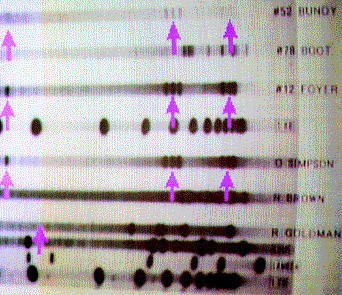DNA Fingerprinting
Figure 14 shows the DNA fingerprints a prosecuting attorney presented in a rape trial in 1987. They consisted of autoradiographs, parallel bars on X-ray film resembling the line patterns of the universal price code found on groceries. Each bar represents the position of a DNA restriction endonuclease fragment. The lane with many bars represents a standardized control. Two different probes were used to identify the restriction fragments. A vaginal swab had been taken from the victim within hours of her attack; from it semen was collected and the semen DNA analyzed for its restriction endonuclease patterns.
Compare the restriction endonuclease patterns of the semen to that of the suspect Andrews. You can see that the suspect’s two patterns match that of the rapist (and are not at all like those of the victim). Clearly the semen collected from the rape victim and the blood sample from the suspect came from the same person. The suspect was Tommie Lee Andrews, and on November 6, 1987, the jury returned a verdict of guilty. Andrews became the first person in the United States to be convicted of a crime based on DNA evidence.
Since the Andrews verdict, DNA fingerprinting has been admitted as evidence in more than 2000 court cases (figure 15). While some probes highlight profiles shared by many people, others are quite rare. Using several probes, identity can be clearly established or ruled out.
Just as fingerprinting revolutionized forensic evidence in the early 1900s, so DNA fingerprinting is revolutionizing it today. A hair, a minute speck of blood, a drop of semen can all serve as sources of DNA to damn or clear a suspect. As the man who analyzed Andrews’ DNA says: “It’s like leaving your name, address, and social security number at the scene of the crime. It’s that precise.” Of course, laboratory analyses of DNA samples must be carried out properlysloppy procedures could lead to a wrongful conviction. After widely publicized instances of questionable lab procedures, national standards are being developed.
The genomes of several organisms have been completely sequenced. When DNA is digested with restriction endonucleases, distinctive profiles on electrophoresis gels can be used to identify the individual that was the source of the tissue.
 Figure 14
Figure 14
Two of the DNA profiles that led to the conviction of Tommie Lee Andrews for rape in 1987. The two DNA probes seen here were used to characterize DNA isolated from the victim, the semen left by the rapist, and the suspect. The dark channels are multiband controls. There is a clear match between the suspect’s DNA and the DNA of the rapist’s semen in these.  Figure 15
Figure 15
The DNA profiles of O. J. Simpson and blood samples from the murder scene of his former wife from his highly publicized and controversial murder trial in 1995.